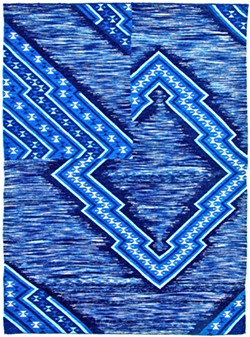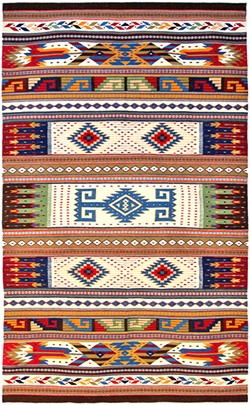Artist Porfirio Gutiérrez can't remember exactly when people started referring to him as a master weaver, but the title has stuck for some time now.

- Images Courtesy Of Porfirio Gutiérrez
- AUTHENTIC Ventura-based artist Porfirio Gutiérrez uses all natural fibers and dyes to weave pieces such as The Journey of the Better Flies.
"It's tough to measure what qualifies you as a master weaver," Gutiérrez said. "[Perhaps it's] when you reach a certain ability of design and techniques, when you start showing a valuable quality of work."
Growing up in Oaxaca, Mexico, as part of the Zapotec culture, Gutiérrez was never asked if he was interested in learning to weave. Rather, it was expected that he would because that's what his father and his people did. After moving to California, though, Gutiérrez stopped weaving for a time and then picked it back up after he realized he actually missed the work. The Ventura-based artist's work is currently on display at the San Luis Obispo Museum of Art as part of the Man of Two Worlds exhibit.
"Weaving has been in my tradition for thousands of years," Gutiérrez said. "In my family and in my community, we come from textile artists and weavers. It is an art form and something I actually like and love to do."
Gutiérrez takes his inspiration from the Zapotec people, myths, and art, as well as from modern art and culture here in the U.S. He uses wool—and palm leaves, on occasion—for his weavings, which are dyed with natural materials like fruit, herbs, and insects to create contemporary, abstract, and colorful tapestries, like The Journey of the Better Flies and Door to the Spirit World. On average, the master weaver's pieces can be anywhere from 24 by 38 inches to 4.5 feet by 6 feet in size. A piece can take weeks, or even months, to complete.
"I'm really drawn to the raw materials," Gutiérrez said. "I don't want to put a title on it; I'm just someone who has found fibers and works to put expression into what I do."

- Images Courtesy Of Porfirio Gutiérrez
- THE LINE Master Weaver Porfirio Gutiérrez takes inspiration from both his upbringing as part of the Zapotec culture in Oaxaca, Mexico, and his life in America in pieces like Door to the Spirit World.
Above all, Gutiérrez hopes that viewers of his work take away a sense of who he is and where he's from.
"I am a big protector of tradition of materials and techniques," Gutiérrez said. "I'm a big defender and proud of the Zapotec culture. I hope people take away these things I'm proud of. I hope they're able to understand that and that it evokes interest in what they're looking at." Δ
Arts Writer Ryah Cooley goes back and forth. Contact her at rcooley@newtimesslo.
Comments